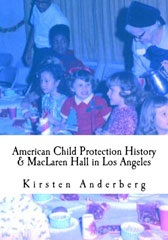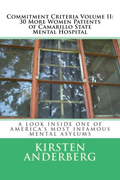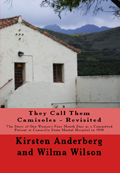I have spent the last few years researching the history of MacLaren Hall in archives and this is some of what I have found thus far...This article took 6 months to research and write, and it took many more hours to format it for the internet. My work here includes a clear profile of who the children were that were thrown together in this Dark Ages warehouse in Los Angeles County. I would like to thank the Historical Society of Southern CA and California State University at Northridge for their support and assistance in my research of MacLaren Hall.
MacLaren Hall in Los Angeles Times Archives from the 1940's to 1970
The punishment of children for their parents' crimes has been a constant throughout American history. With the Elizabethan Poor Laws of the 1600's, came a legal distinction between the "worthy poor" and the "unworthy poor," and the children of the "unworthy poor" often became collateral for their parents. Many children from backgrounds of poverty were shipped from England to America in its early days of settlement as "indentured servants," which by all accounts surmounted to the children being sold into slavery by their parents to pay off familial debts. Orphaned and abandoned children placed in institutions during the Industrial Revolution became cheap labor for the profits of adults around them, as well. Even after child labor laws prevented such activities, children who suffer from abandonment, neglect, abuse, and/or are orphaned under unfortunate circumstances, face a societal battle trying to fight off stigma, poverty, and more abuse as children in state protective custody and foster homes.
In 1960, Carolyn Page, then aged 4, survived her mother trying to kill her, as well as her two younger siblings. The children were taken to a state protective custody institution named "MacLaren Hall."[1] They were then placed in a foster home, and by 1961, at age 5, Carolyn was dead from strangulation while being tied up for 6 hours and left alone in a shower by her foster parents as "punishment."[2] She was failed by three sets of adults: her parents, MacLaren Hall, and her foster parents. This is the story of MacLaren Hall. It is an institutional history that embodies the progress and mistakes of child protection in modern-day terms. In reviewing the history of MacLaren Hall, my desire is to inspire a more civilized treatment of innocent children who end up near prey for bad adult behavior, by humanizing one story of abuse and horror as it occurred in the middle of the 20th century, hidden in the heart of one of America's largest cities, Los Angeles, CA.
To understand the history of MacLaren Hall, a study into the history of child institutions, and institutions, in general, is helpful. Researching the treatment of poor children, and the poor, in general, throughout history, also serves our purposes here. As I have stated, in the 1600's, the Elizabethan Poor Laws distinguished between the "worthy poor" and the "unworthy poor." In Robert L. Geiser's book, The Illusion of Caring, (1973: Beacon Press, Boston), he writes about this societal distinction, "…for the unemployed but willing to work, there was the workhouse…Finally, those who would not work (the unworthy poor, the able-bodied poor, sturdy beggars, or the valiant rogues, as they were also called), there was the House of Corrections. This was really more of a jail for misdemeanors where the inmates were forced to work."[3] Our current "Department of Corrections," aka the jail/prison system, has origins in workhouses and the House of Corrections model.
It is interesting to note that MacLaren Hall was run by the Department of Probation, not state social services agencies. This was due to the criminality of MacLaren Hall children's parents, primarily. Their parents were often in custody of the jail system, and thus the children taken into custody were also routed through the jail system's Department of Probation. This also explains why MacLaren Hall was run like a jail, having been staffed and administrated by people who ran jails, not children's centers.
Additionally, children fell under the "unworthy poor" category with their parents, thrown into workhouses or poor houses alongside adults in the 1600's, up until the mid- 1800's, as children were deemed ready for employment at ages we now consider inappropriately young. Michel Foucault, in his classic book, "Madness and Civilization," (1965: Random House, New York), says, "in 1657, an official edict was sent down prohibiting and forbidding "all persons of either sex, of any locality and of any age…in whatever condition they may be, able-bodied or invalid…curable or incurable…to beg in the city and suburbs of Paris, neither in the churches, nor at the doors…nor anywhere else in public or in secret by day or night…under pain of being whipped for the first offense, and for the second condemned to the galleys if men and boys, banished if women and girls.""[4] Foucault then goes on to say that in April 1684, after begging became illegal, the administrators of the General Hospital in Paris began "hunting down" beggars on the streets and "herding them" into different buildings at the General Hospital. There, the girls and boys under 25 years of age were ordered to work for "the greater part of the day," and they were also to spend time on "the reading of pious books," to reform their sinful ways that made them poor.[5]
In the 1600's, children were not only criminalized for begging, but were also sentenced to work in institutions as punishment alongside adults, without differentiation, for their poverty. This is important as this sets the tone for the treatment of children caught in poverty in modern times. Alike the situation in Paris, during the 1600's, children who were caught begging on streets or were found in almshouses in Britain were being sold by British companies to American businessmen as cheap labor. R. Geiser writes that "in 1619-1620, the Virginia Company of London recruited in the almshouses and among the poor of London children to strengthen and increase its settlement in the New World. A hundred children over 12 years of age were sent the first year, but a number of them died on that long and difficult trip." He writes that in 1627, ships again left England with 1,500 children bound for labor in Virginia, noting that this not only was a source of cheap labor but also England saw this as "a way of ridding itself of dependents who otherwise would be a burden on the local parishes."[6] Geiser also says that in 1654, the Dutch East Indian Company "sought to increase the population of New Amsterdam (New York City) by sending several hundred children to the colony from the almshouses of Dutch cities."[7] This attitude that abandoned, neglected, and abused children, living in poverty, are either a cheap work force worthy of exploitation or a burden communities want to pass onto someone else, like a hot potato, has remained constant for over 300 years in European and American society.
R. Geiser writes, "Once the colonies were established, indenture became a method of dealing with the children of colonists who had been orphaned, neglected, or who were illegitimate or ill-stricken. Shortly after the founding of the colony in Massachusetts, for example, the first child was placed out by public authority. The year was 1636 and the child's name was Benjamin Eaton." Benjamin Eaton was "probably 7 years old" when he was "placed out." Geiser continues, "In New York City, in 1725, there are records of an 18 month old being bound out as an indentured servant, and in 1726, New York City records show the indentured servitude of a four year old."[8] Geiser writes that in 1750, the newspapers in New York City were advertising "that the almshouse had two children, boys eight and ten, waiting for suitable apprenticeships. In 1794, a total of 94 children were bound out from the New York Almshouse."[9] All of this is relevant to MacLaren Hall's history as it shows how we have dealt with the same population of children who landed in MacLaren Hall, in centuries past, and it is a roadmap that leads to today's situation with the same population of children in America. The profile of these children remains the same across the centuries and countries; the ways societies interact with them changes with time.
An enduring stigma is attached to this population of children who are abandoned, neglected, and poor, throughout the centuries, as well. Indeed, as I will show later in this paper, many children taken to MacLaren Hall did come from homes of filth, but that was of no fault of their own. Foucault, in his book "Discipline and Punish: The Birth of the Prison" (1977: Random House, NY), says that in the mid-1700's, Jean-Baptiste de la Salle "dreamt of a classroom in which the special distribution might provide a whole series of distinctions at once: according to the pupils' progress, worth, character, application, cleanliness and parents' fortune." Foucault quotes de la Salle as saying the classroom must be arranged in a way that "those whose parents are neglectful and verminous must be separated from those who are careful and clean; that an unruly and frivolous pupil should be placed between two who are well behaved and serious, a libertine either alone, or between two pious pupils."[10] Foucault also says that a little before de la Salle's statements, Batencour said that classrooms should have a bench for the rich and a bench for the poor, "so the vermin will not be passed on."[11] This concept of isolating poor children from other children, and society at large, is one we will see repeatedly. This behavior also surmounts to a discrimination against, and punishment of, children who are victims of child abuse and neglect, while it also serves as a justification for the further abuse of these children, as a societal punishment for their parents' irresponsible behaviors through the punishment of their children...
This leads into another very interesting coincidence between past centuries, institutions and MacLaren Hall. Foucault says that in the mid-1600's, there was a movement by the "royal authority" for the "control and reorganization of the immense fortune represented by the endowments of the lazar houses"[15] due to the curing of leprosy, and thus there was a move to use the abandoned asylums once used by leprosy victims, who had to be segregated from society, for other groups deemed worthy of segregation in a like manner. Foucault says that insane asylums were literally created as a populace to fill up emptied leprosy institutions. Foucault notes one of the emptied leprosy houses became a "reformatory for young criminals,"[16] and that by July 1695 "the goods of the lazar houses were thenceforth assigned to other hospitals and welfare establishments."[17] This is important as MacLaren Hall came to replace a former polio hospital, in a time when polio was also being eliminated in a similar manner to leprosy in the past. Entire asylums were left empty and populations were created to fill them...
In 1964, MacLaren Hall, a child protection institution run by the County of Los Angeles' Probation Department, took in approximately 4,000 children annually.[26] In 1967, there were 1,400 residential child welfare institutions in the U.S. One hundred and fifty of them were public, the rest were private. In 1967, these child institutions could house 94,000 children and were at an 83% occupancy rate with 78,400 kids in residence.[27] In 1967, MacLaren Hall was one of the 150 public residential child welfare institutions in operation in America...
The institutional grounds that later became known as MacLaren Hall followed the pattern of Foucault's abandoned leprosy asylums, as it was an abandoned polio asylum. According to her 1967 obituary, Ruth K. Kerr (of the Kerr Glass Manufacturing Co., best known for canning jars), in 1930, "sponsored a campaign to build a hospital, home and school known as the Ruth Home in El Monte for children and young girls suffering from social diseases. Later it was taken over by the Sister Kenny Foundation. In 1959, the county purchased the property to house juvenile wards and named it MacLaren Hall."[28] "MacLaren Hall was built by the Works Progress Administration in the 1930's," according to a 1970 Los Angeles Times article.[29] A 1964 article writes "The building was first used for delinquent teen-age girls but later became the Sister Kenny Foundation home before being used for non-delinquent children."[30] And an article dated 1964 says, "MacLaren Hall, the former Sister Kenny Nursing Home for polio victims near El Monte, was built in 1926."[31] Some of the dates in the L.A. Times' archives are conflicting, but the general time period seems consistent.
A 1960 article reads, "The crutches and wheelchairs are gone from the verdant lawns of the vast Sister Kenny Polio Hospital, and so, too, is one of mankind's most dread cripplers. Discovery of Salk vaccine put a climax to the heroic polio saga of Elizabeth Kenny. But it raised the curtain on MacLaren Hall, a facility which will provide an equally important service to the public." The article speaks of a target date for the completion of MacLaren Hall as February 1961, with a cost of $800,000. "This place began as a home for unwed mothers,"said Bob Disterdick, executive assistant for the probation department. "Later it became a venereal disease hospital, and finally the Kenny therapy center. Those problems are all pretty much taken care of now, so if we come up with a way to eliminate the causes of delinquency, we'll have it made," he added."[32]
The 15 acre Sister Kenny compound, located at 4039 Gilman Road, in El Monte, was taken over by the L.A. County Probation Department in early 1960 and was slated to house 150 children up to age 18. Disterdick's comments above, implying there would be no need for MacLaren Hall if there was an elimination of delinquency, is in direct conflict with a statement he makes directly after that comment, in the same article. He says the youngsters, "who will be transferred here from Juvenile Hall early next year are nondelinquents."[33] The article also quotes him saying "they're merely dependent and neglected children, mostly from broken homes, who must be held in protective custody until their problems can be worked out."[34] The Probation Department was responsible for both delinquent and non-delinquent children, and MacLaren Hall resembled a prison more than a children's home, due to this fact. Additionally, MacLaren Hall was proposed to the public as a safety valve for the overcrowded Juvenile Halls and children filling MacLaren Hall originally came from the Juvenile Hall. Thus it was common for MacLaren Hall children to be marked with the stigma of criminals and delinquents, when they were merely victims of abuse and neglect.
Disterdick continues in this 1960 article to say the new MacLaren Hall "has the space and facilities to create an entirely different kind of atmosphere than that of Juvenile Hall," although he adds that it is far from ideal as a youth shelter. "The county purchased this for the simple reason that there is no other place where the county could get this much bed space at so cheap a price…Most of the buildings were not up to code standards," said Disterdick.[35] This article also speaks about the installation of "perimeter security measures, which include flood lights and a 14 foot chain link fence, topped by five feet of wire mesh (barbed wire)…Among new features will be a small courtroom in one wing which will make it unnecessary for authorities to transport a child to Los Angeles for hearings, and a library." This remodel was made possible due to a $1.5 million bond which passed in 1956.[36]
Although most of the written records speak of MacLaren Hall as opening in 1961, there are articles from the L.A. Times archives that show children were being taken to "MacLaren Hall" in the 1940's. An article dated July 2, 1949, reads: "Earl C. McElwee, a 32 year old father, admitted to starving his 2 month old child to death in the summer of 1949." At that time of the father's arrest, he had 3 other children: Edna, 9, William 7, and Mary, 20 months. After the arrest, "Edna June and Mary Margaret were taken to Juvenile Hall. William was taken to MacLaren Hall, 777 N. Gilman Road, El Monte."[37] This address of 777 N. Gilman Road, is close to the previous address given for the Ruth House and Kenny Hospital at 4039 Gilman Road thus I cannot ascertain whether MacLaren Hall was previously in existence at another location before it moved to the 4039 Gilman location, but such an assumption is plausible...
(This article was written and copyrighted in 2009 by Kirsten Anderberg, All Rights Reserved. If you would like permission to copy or reproduce any part of this article, please contact kirstena@resist.ca)
Footnotes:
1. Los Angeles Times, Murder Charge to Be Asked in Carolyn Death, (1961, September 20), p. b2. (This and all Los Angeles Times articles referenced in this paper were retrieved from Proquest Archives.)
2. Los Angeles Times, Couple in Carolyn Case Lose Custody of Infant, (1961, September 24), p. g2.
3. Robert L. Geiser, The Illusion of Caring, (1973: Beacon Press, Boston), pp. 150 - 151.
4. Ibid. 48.
5. Michel Foucault, Madness and Civilization, (1965: Random House, NY), p. 60.
6. Robert L. Geiser, The Illusion of Caring, p. 138.
7. Ibid., p. 146.
8. Ibid., pp. 147-148.
9. Ibid., p. 153.
10. Michel Foucault, Discipline and Punish: The Birth of the Prison, (1977: Random House, NY), p. 147.
11. Ibid., pp. 314-315.
12. Timothy A. Hacsi, Second Home: Orphan Asylums and Poor Families in America, (1997: Harvard University Press: Cambridge, MASS), p. 137.
13. Robert L. Geiser. The Illusion of Caring, p. 150.
14. Ibid., pp. 153-154.
15. Ibid., p. 4.
16. Ibid., p. 4.
17. Ibid., p. 4.
18. Ibid., p. 157.
19. Ibid., p. 157.
20. Timothy A. Hacsi., Second Home: Orphan Asylums and Poor Families in America, p. 117.
21. Ibid., p. 109.
22. Ibid., p. 119.
23. Robert L. Geiser, The Illusion of Caring, pp. 161-163.
24. Ibid., p. 167.
25. Timothy A. Hacsi, Second Home: Orphan Asylums and Poor Families in America, p. 148.
26. Los Angeles Times, County's Deprived Children Find a Home Away From Home, (1964, September 16), p. g9.
27. Robert L. Geiser, The Illusion of Caring, p. 167.
28. Los Angeles Times, Rites to Be Wednesday for Mrs. Ruth K. Kerr, (1967, November 7), p. a8.
29. Ray Zeman, Los Angeles Times, Sheriff Patrol Charge to Cities Set at $230,043 for Each Car: Increase From $139,131 Annually for 30 Municipalities Contracting for Services OKd by County Pending Study, (1970, April 8), p. d5.
30. Los Angeles Times, Board's Bond Action Hailed by MacLaren : $35.2 Million Proposal Includes Funds for Expansion of County Juvenile Home, (1964, August 14), p. sg8.
31. Los Angeles Times, MacLaren Hall Plans Accepted, (1964, August 10), p. b8.
32. Charles Gould, Los Angeles Times, New MacLaren Hall to House Juvenile Wards: Sister Kenny Polio Hospital Being Converted by Probation Department, (1960, November 6), p. sg1.
33. Ibid.
34. Ibid.
35. Ibid.
36. Ibid.
Thank you to Resist.ca for hosting this website! * Return to Home Page



